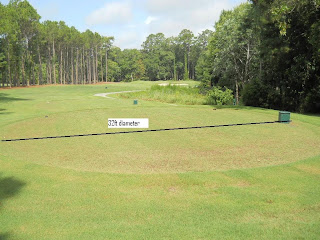In the above picture, you can see the old style circular tee shape. This tee was 32 foot in diameter. Simple math gives this tee an overall area of 803 square feet.
The new rectangular tee shape allows us to gain square footage using the same area. The new tee is 1,080 square feet. We gained 200 square feet on the same area by changing the shape and direction of our teeing surface. The photo above is #11 at the Players Club, a par 3 that was in dire need of more teeing surface.
We didn't expand on every tee. Some tees were reduced in size. A few tees were unnecessarily expansive. Here is a picture from number 2 at the Players Club detailing a tee that we reduced in size.
The blue lines show the new tee width. The red lines show the old tee width. This is just one example of how we reduced tee sizes without sacrificing teeing ground. On the tee above, 99% of the divots were on the center-right of the tee. The left side of the tee was barely, if ever utilized. In this case we simply pinched the tee in on both sides by roughly four feet. This type of size reduction throughout the course will increase our mowing efficiency without surrendering playability.
Another aspect of the tees that we needed to correct was the direction in which they where pointed. The photo below is number 1 at the PC.
The red lines show the old tee direction and the blue shows the new tee. The old tee was directed into the woods. We moved the tee slightly ahead and turned the direction in which the tee was facing. This helps us to ensure that our tee placements point directly at the fairway, regardless of who is moving them.
This project is currently on trial at the Players Club. You will notice some scalping in areas that we expanded some tees. Our hope is that we can improve our efficiency and increase the consistency of tee placement across the plantation. If successful at the Players Club, we plan to implement these changes at the Members and the Founders Clubs.
We didn't expand on every tee. Some tees were reduced in size. A few tees were unnecessarily expansive. Here is a picture from number 2 at the Players Club detailing a tee that we reduced in size.
 |
| Please forgive my poor artwork. |
The blue lines show the new tee width. The red lines show the old tee width. This is just one example of how we reduced tee sizes without sacrificing teeing ground. On the tee above, 99% of the divots were on the center-right of the tee. The left side of the tee was barely, if ever utilized. In this case we simply pinched the tee in on both sides by roughly four feet. This type of size reduction throughout the course will increase our mowing efficiency without surrendering playability.
Another aspect of the tees that we needed to correct was the direction in which they where pointed. The photo below is number 1 at the PC.
The red lines show the old tee direction and the blue shows the new tee. The old tee was directed into the woods. We moved the tee slightly ahead and turned the direction in which the tee was facing. This helps us to ensure that our tee placements point directly at the fairway, regardless of who is moving them.
This project is currently on trial at the Players Club. You will notice some scalping in areas that we expanded some tees. Our hope is that we can improve our efficiency and increase the consistency of tee placement across the plantation. If successful at the Players Club, we plan to implement these changes at the Members and the Founders Clubs.



No comments:
Post a Comment